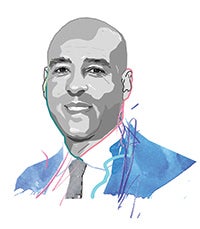
Educating the Whole Student
A note from President Reginald DesRoches

Winter 2024
On a recent trip to New York City, I met a Rice graduate who had double-majored in computer science and art. He’s working in the financial sector, where many of his colleagues have a background in business or economics.
He talked about how his unusual combination of majors has enabled him to tackle the daily challenges of his job. His computer science background has been helpful in analyzing and interpreting complex data, while his art degree has equipped him with skills he didn’t realize would be so valuable, including creative self-expression and empathy, both of which have allowed him to be open to other people’s perspectives and engage effectively in complex problems. What has surprised him even more is that these qualities are setting him apart from his peers.
During my time at Rice, I have come to learn that double and even triple majors that combine the arts and humanities with STEM or business are not uncommon and are often advantageous. I am proud of the depth and breadth of studies, coupled with flexibility, that Rice offers our students, and I believe it sets them up not only for success but also to have true impact on the world. Today’s higher education landscape demands that we educate the whole student, because problem-solving and innovation require the kind of critical thinking and creativity that come only from exposure to a wide range of knowledge, skills and ways of thinking.
Now and in the future, innovation will come from the intersection of humanities, technology, arts and sciences, and other areas of study. This confluence of knowledge happens at all levels — undergraduate, graduate and postgraduate — and across all disciplines.
Now and in the future, innovation will come from the intersection of humanities, technology, arts and sciences, and other areas of study. This confluence of knowledge happens at all levels — undergraduate, graduate and postgraduate — and across all disciplines. — President DesRoches
The stories in this issue of Rice Magazine recognize the excellence we offer across the board at Rice — from the cover feature on lauded composer and Shepherd School alumna Gabriela Lena Frank ’94, ’96 to Rice’s expanding research partnerships with the Texas Medical Center and a newly established postdoctoral research fellowship in African and African American studies made possible by a consequential gift to the School of Humanities.
This excellence is also on view in the newest “Tent Series” from Rice’s Moody Center for the Arts. The “tents,” technically known as Provisional Campus Facilities, were originally placed during COVID-19 as flexible spaces to be used for classes and other events. Now, they are a canvas for Houston-based artists, including one right here at Rice — and you can read about them here.
Looking ahead, Rice University is becoming ever more vibrant. With unwavering dedication to a broad-based liberal arts education, a dynamic and supportive city as our backdrop, and the steadfast support of our loyal alumni, we are well positioned to become one of the premier full-spectrum research universities, with a unique commitment to teaching and learning inside and outside the classroom.
It is an exciting time to be at Rice. The tapestry of diverse accomplishments showcased in this magazine is a testament to the collective brilliance and assiduity of our students, staff, faculty and alumni. As we navigate the myriad opportunities and challenges on the horizon, we do so with the knowledge that Rice’s impact extends far beyond the hedges, shaping not only the future of our university but also the broader landscape of education and innovation.
